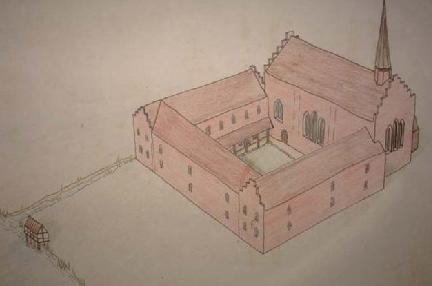
The village of Faarvang

| The village of Faarvang | Index |
The village of Faarvang is found in the middle of the Jutland peninsula between the towns of Viborg in the west, Århus in the east, Silkeborg in the south and Randers in the north.
About two miles south of Faarvang you find the church of Tvilum. Until the Danish Reformation in 1536 this was the home of one of Denmark’s biggest and richest monasteries. The buildings of the monastery were torn down shortly after the reformation, but the church still bears signs of its Catholic past, and its size alone sends a signal of wealth and power.

Reconstruction drawing of the monastery at
Tvilum
The monastery at Tvilum, as with so many churches in medieval Denmark, was very rich. Throughout 500 years as the official church of the Danes, the Catholic Church had gathered enormous wealth in money and land. Often lands and possessions were inherited in return for the promise of a safe journey to heaven, but especially in the late period (1400 to 1536) the enormous income from the very profitable sale of indulgences was invested wisely. At the time of the Reformation the monastery of Tvilum possessed vast land in the area and probably had a large number of domestic animals. A hypothesis on the origin of the name Faarvang is that it marked the area where the monks had their sheep, as faar-vang can be translated to sheep-field.
In Denmark, as in many other countries, family names have gone through numerous developments over the centuries. In the times of the Vikings many people were given names after abnormalities or specialities (Two-beard, Blue-tooth). In early medieval times many names originated in religion or crafts (Peter, Carpenter), but later the fashion was to give the children family names after their father’s first name: Peterson (son of Peter) or Nielsdatter (daughter of Niels). As of course some names became very common, it became popular to add a nickname describing where the person came from (Niels Peterson of Hammel or Christine Nielsdatter of Tvilum). In the end some of the more common names were cast away, and the remaining family name would be the village the family came from. Examples are numerous, and Faarvang is just one of many. The identity of the first bearer of the name has not yet been revealed, but the change of family name seems to have taken place around 1800.

Tvilum church 2003
The Faarvang family have probably lived in the area of mid-Jutland for generations. It wasn’t until the end of the 19th century that it became normal to move around, although the adscription had been lifted in 1788. The explanation was that the cost of moving was high, and many feared the unknown outside the village. Their “world” therefore consisted of the village and, for some, the occasional trip to the market town. The representatives of the state were the vicar and the schoolmaster, who both were considered authorities. Nothing indicates that the Faarvang family was special; in other words, they were poor! We know from the archives that they were farmers or smallholders. Their farms had very little land, some were even without their own land. Some left for the towns and became craftsmen, but they still belonged to the poorer part of the population.
For more information contact webmaster@faarvang.org